
Architecture of Mongolia
Encyclopedia

Mongolia
Mongolia is a landlocked country in East and Central Asia. It is bordered by Russia to the north and China to the south, east and west. Although Mongolia does not share a border with Kazakhstan, its western-most point is only from Kazakhstan's eastern tip. Ulan Bator, the capital and largest...
n dwelling is known as yurt
Yurt
A yurt is a portable, bent wood-framed dwelling structure traditionally used by Turkic nomads in the steppes of Central Asia. The structure comprises a crown or compression wheel usually steam bent, supported by roof ribs which are bent down at the end where they meet the lattice wall...
. According to Mongolian artist and art critic N. Chultem, yurts and tent
Tent
A tent is a shelter consisting of sheets of fabric or other material draped over or attached to a frame of poles or attached to a supporting rope. While smaller tents may be free-standing or attached to the ground, large tents are usually anchored using guy ropes tied to stakes or tent pegs...
s were the basis for the development of traditional Mongolian architecture. In the 16th and 17th centuries, lamaseries were built throughout the country. Many of them started as yurt-temples. When they needed to be enlarged to accommodate the growing number of worshippers, the Mongolian architects used structures with 6 and 12 angles with pyramidal roofs to approximate to the round shape of a yurt. Further enlargement led to a quadratic shape of the temples. The roofs were made in the shape of marquees.
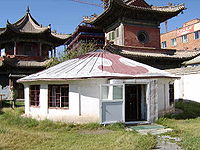
Chultem distinguished three styles in traditional Mongolian architecture: Mongolian, Tibetan and Chinese, as well as combinations of the three. Among the first quadratic temples was Batu-Tsagaan (1654) designed by Zanabazar. An example of the yurt-style architecture is the Dashchoilin khiid monastery in Ulaanbaatar
Ulaanbaatar
Ulan Bator or Ulaanbaatar is the capital and largest city of Mongolia. An independent municipality, the city is not part of any province, and its population as of 2008 is over one million....
. The Lavrin temple (18th century) in the Erdene Zuu
Erdene Zuu monastery
The Erdene Zuu Monastery is probably the most ancient surviving Buddhist monastery in Mongolia. It is in Övörkhangai Province, near the town of Kharkhorin and adjacent to the ancient city of Karakorum...
lamasery was built in the Tibetan tradition. An example of a temple built in the Chinese tradition is the Choijin Lama Süm temple (1904), which is a museum today. The quadratic Tsogchin temple in Gandan monastery in Ulaanbaatar is a combination of the Mongolian and Chinese tradition. The Maitreya temple (disassembled in 1938) was an example of the Tibeto-Mongolian architecture. Dashchoilin khiid has commenced a project to restore this temple and the 80-feet sculpture of Maitreya. Also influence of the Indian architecture is significant, especially in the designs of Buddhist stupa
Stupa
A stupa is a mound-like structure containing Buddhist relics, typically the remains of Buddha, used by Buddhists as a place of worship....
s.
Socialist-era Mongolian architects on some occasions continued to use traditional elements, like round shapes (e.g. restaurants Tuyaa (nowadays "Seoul") and Khorshoolol (nowadays "KhanBräu")) or meandering ornaments (on many of the residential towerblocks).
Medieval Period
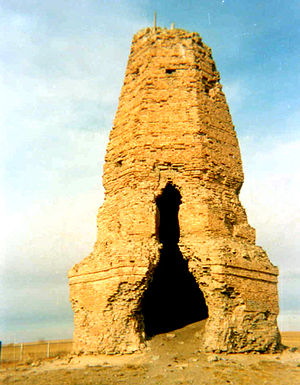
Xiongnu
The Xiongnu were ancient nomadic-based people that formed a state or confederation north of the agriculture-based empire of the Han Dynasty. Most of the information on the Xiongnu comes from Chinese sources...
, who ruled what is today Mongolia from the 3rd century BCE through the 1st century CE, were portable round-shaped tents on carts as well as round-shaped yurts. The Xiongnu aristocracy lived in small palaces, and their villages were protected by huge walls. S. I. Rudenko also mentions about capital construction built of logs. Archaeological excavations witness that the Xiongnu had towns. Their main city was called Luut Hot (City of Dragon).
Powerful statehoods were built by Turkic
Turkic peoples
The Turkic peoples are peoples residing in northern, central and western Asia, southern Siberia and northwestern China and parts of eastern Europe. They speak languages belonging to the Turkic language family. They share, to varying degrees, certain cultural traits and historical backgrounds...
and Uigur tribes, who from the 6th through the 9th centuries, dominated what is now Mongolia. Several Turkic cities and towns existed in the basin of the rivers Orhon, Tuul and Selenge. The main city of the Turkic Kaganate was Balyklyk. The Uigur Kaganate that succeeded the Turks centered on the city Kara Balgasun
Ordu-Baliq
Ordu-Baliqalso spelled Ordu Balykh, Ordu Balik, Ordu-Baliq, Ordu Balig, Ordu Baligh , also known as Mubalik, was the capital of the first Uyghur Empire, built on the site of the former Göktürk imperial capital, 17 km north-to-northeast of the later Mongol capital, Karakorum...
founded in the beginning of the 8th century. A fragment of the 12 metre high fortress wall with a watch tower has been preserved. There was a large trades and craftswork district in the city. Their architecture was influenced by the Sogdian
Sogdiana
Sogdiana or Sogdia was the ancient civilization of an Iranian people and a province of the Achaemenid Empire, eighteenth in the list on the Behistun Inscription of Darius the Great . Sogdiana is "listed" as the second of the "good lands and countries" that Ahura Mazda created...
and Chinese traditions. The Uigur Kaganate was routed by their warlike neighbours Kirghiz, who destroyed the advanced culture of the Uigurs. The cultural development of the country was thrown back to the primitive stage.
Archaeological excavations discovered traces of cities of the Kidan period in Mongolia which lasted from the 10th to the 12th centuries. The most significant of the excavated cities was Hatun Hot founded in 944. Another significant Kidan city was Bars-Hot in the basin of the river Kerulen. It occupied an area of 1600x1810 metres and was surrounded with mud walls, which are today 4 metres thick and 1.5–2 metres high. A remnant of a stupa
Stupa
A stupa is a mound-like structure containing Buddhist relics, typically the remains of Buddha, used by Buddhists as a place of worship....
is found near the walls. There used to be a pair of them, but in the 1940s the Soviet garrison used cannon fire to destroy one for amusement.
Yurts

In the 12th and 13th centuries, ger-tereg (yurts on carts) were built for the khans and chieftains. Iron bushes of enormous dimensions for the shafts of a cart were found during excavations of Karakorum
Karakorum
Karakorum was the capital of the Mongol Empire in the 13th century, and of the Northern Yuan in the 14-15th century. Its ruins lie in the northwestern corner of the Övörkhangai Province of Mongolia, near today's town of Kharkhorin, and adjacent to the Erdene Zuu monastery...
. The distance between the wheels of such a cart would be over 6 metres and it would be pulled by 22 oxen. Such ger-teregs are mentioned in the Secret History of the Mongols.
A common arrangement of a yurt camp in the medieval Mongolia was huree (kuren) (meaning "circle"), in which the yurt of the khan or chieftain was located in the centre and the yurts of the other members of the tribe were placed around it. This arrangement had a defensive function in the conditions of frequent skirmishes. Huree was replaced by ail (meaning "neighbourhood") arrangement in the 13th and 14th centuries during the unified Mongol Khanate when internal wars had stopped. Huree arrangement came back after the disintegration of the Mongol Khanate in the 15th century. It became the basis for the arrangement of the monasteries that were initially founded as mobile monasteries (the other type of monasteries being "khiid" following the Tibetan arrangement) in the 16th and 17th centuries when Buddhism was firmly re-introduced. As huree-monasteries and huree-camps of nobles settled and grew up into towns and cities, the names of such settlements retained the word huree as a necessary component (e.g., Niislel Huree, Zasagtu Khaan-u Huree).


The internal organisation and furnishing mirrors the traditional roles of the family members as well as spiritual concepts, giving special significance to each of the cardinal directions, with the door always facing south. Herders use the position of the sun in the crown of the yurt as a sundial. The northeastern quarter of the yurt is reserved for the woman. The man was traditionally prohibited entering this quarter and touching the woman when she is in this quarter in case of a family conflict, while she was allowed to throw hard objects such as scissors at the husband from this position.

In the 21st century, between 30% and 40% of the population live in yurts, many of them in the suburbs of cities. The Mongolian word "ger" has additional connotations of "home". The stylistically elevated register for ger is örgöö, most commonly translated as "residence" or "palace".
Tents
Tents also played a role in the formation and development of the unique Mongolian architecture. Although they are temporary shelters, they were used more frequently in the conditions of pastoralism. Tents were also used during Naadam festivals, feasts and other sorts of gatherings.- Jodgor is a small tent to accommodate one or two persons.
- Maihan is a large tent for a group of people.
- Tsatsar is a fabric shade on vertical supports without vertical walls.
- Tsachir is a large rectangular tent with vertical fabric walls.
- Asar is a generic name for tsatsar and tsachir.
Giovanni da Pian del Carpine ("History of the Mongols") reported, during the ceremony of enthronement of Guyuk Khaan in 1246, a colossal marquee-tsachir, capable of hosting 2000 people, was erected at the river Tamir. The marquee was supported by pillars decorated in gold leaves, and the internal side of the walls were covered with canopy.
Later, the designs of many temples were based on tsachir.
Imperial Period
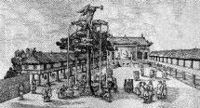
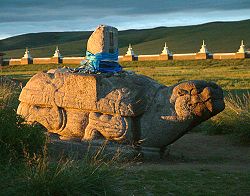
Karakorum
Karakorum was the capital of the Mongol Empire in the 13th century, and of the Northern Yuan in the 14-15th century. Its ruins lie in the northwestern corner of the Övörkhangai Province of Mongolia, near today's town of Kharkhorin, and adjacent to the Erdene Zuu monastery...
, capital of the Mongol Empire
Mongol Empire
The Mongol Empire , initially named as Greater Mongol State was a great empire during the 13th and 14th centuries...
, were first rediscovered and studied by the expedition of S. V Kiselev. Karakorum was founded in the basin of the river Orkhon by Chinggis Khaan
Genghis Khan
Genghis Khan , born Temujin and occasionally known by his temple name Taizu , was the founder and Great Khan of the Mongol Empire, which became the largest contiguous empire in history after his death....
in 1220 as a major military centre. However, in 15 years it became an administrative and cultural centre of the empire.
In the centre of the city was situated the palace of the Great Khaan—the Tumen Amugulang palace. Based on the records of William of Rubruck
William of Rubruck
William of Rubruck was a Flemish Franciscan missionary and explorer. His account is one of the masterpieces of medieval geographical literature comparable to that of Marco Polo....
, most scholars maintain that in front of the palace was the Silver Tree fountain. However, there is a group of researchers who conclude that the famous fountain was inside the palace. According to Rubruck, there were 4 silver sculptures of lions at the foot of the Silver Tree, and fermented mare's milk—airag, favourite drink of the Mongols, would run from their mouths. Four golden serpents twined round the tree. Wine would run out from the mouth of one serpent, airag—from the mouth of the second serpent, mead from the third, and rice beer from the fourth. The top of the tree was crowned by an angel blowing a bugle. The branches, leaves and fruits of the tree were all made of silver. The fountain was designed by a captive sculptor William of Paris. The Khaan himself would sit on the throne in the north of the yard in front of the palace. Men would sit in a row at the right hand of the Khaan and women would sit to the left.
Excavations partly proved and partly supplemented these descriptions. The buildings were heated by smoke pipes installed under the floors. The Khaan's palace was erected on an artificial platform occupying an area of 2475 sq. metres.
Ogedei Khaan ordered that each of his brothers, sons and other princes build a magnificent palace in Karakorum. The city hosted Buddhist temples, Christian
Christian
A Christian is a person who adheres to Christianity, an Abrahamic, monotheistic religion based on the life and teachings of Jesus of Nazareth as recorded in the Canonical gospels and the letters of the New Testament...
churches and Muslim
Muslim
A Muslim, also spelled Moslem, is an adherent of Islam, a monotheistic, Abrahamic religion based on the Quran, which Muslims consider the verbatim word of God as revealed to prophet Muhammad. "Muslim" is the Arabic term for "submitter" .Muslims believe that God is one and incomparable...
mosque
Mosque
A mosque is a place of worship for followers of Islam. The word is likely to have entered the English language through French , from Portuguese , from Spanish , and from Berber , ultimately originating in — . The Arabic word masjid literally means a place of prostration...
s. There were sculptures of tortoises at each gate on the four sides of the city wall. Steles on the backs of the tortoises were crowned with beacons for travellers in the steppe. The overall construction in Karakorun was supervised by Otchigin, the youngest brother of Genghis Khan.
There were many other cities and palaces throughout Mongolia in the 13th and 14th centuries. Best studied are the ruins of Palace Aurug near Kerulen and Hirhira and Kondui cities in the Trans-Baikal region. The latter two demonstrate that cities grew out not only around the Khaan's palaces but also around residences of the other members of nobility. City Hirhira sprang out around the residence of Juchi-Khasar. The Mongolian aristocrats were dissatisfied with temporary residences and started building luxurious palaces. The palace in Hirhira city was located within a citadel. The palace in Kondui city was built on a platform, surrounded by double-tiered terraces, pavilions and water pools. The archeological excavations revealed traces of conflagrations and the times of the fall of these cities are approximately the same as of Karakorum—late 14th century when the Chinese army repeatedly raided the country and looted the cities though the aggressor was expelled each time. Karakorum was destroyed in 1380 and could never restore its previous magnificence. The long destructive wars waged by China continued from 1372 to 1422 ruining the cultural progress of Mongolia achieved during the imperial period. Mongolia fell back into dark Middle Ages till the second half of the 16th century, when her culture experienced Renaissance.
Renaissance
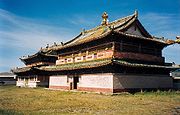

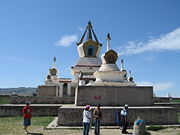
Buddhism
Buddhism is a religion and philosophy encompassing a variety of traditions, beliefs and practices, largely based on teachings attributed to Siddhartha Gautama, commonly known as the Buddha . The Buddha lived and taught in the northeastern Indian subcontinent some time between the 6th and 4th...
in the form of Gelugpa (3rd introduction of Buddhism). Altan Khan
Altan Khan
Altan Khan , whose given name was Anda , was the ruler of the Tümet Mongols and de facto ruler of the Right Wing, or western tribes, of the Mongols...
of Tumet founded city Hohhot
Hohhot
Hohhot , is a city in north-central China and the capital of the Inner Mongolian Autonomous Region, serving as the region's administrative, economic, and cultural centre....
in 1575 as a political and cultural centre of his holdings. Among the first Buddhist monasteries of Mongolia of this period was temple Thegchen Chonchor Ling in Khökh Nuur
Qinghai Lake
Qinghai Lake , is a saline lake situated in the province of Qinghai, and is the largest lake in China. The names Qinghai and Kokonor both mean "Blue/Teal Sea/Lake" in Chinese and Mongolian. It is located about west of the provincial capital of Xining at 3,205 m above sea level in a depression...
built by Altan Khan to memorise his 1577 meeting with Dalai Lama
Dalai Lama
The Dalai Lama is a high lama in the Gelug or "Yellow Hat" branch of Tibetan Buddhism. The name is a combination of the Mongolian word далай meaning "Ocean" and the Tibetan word bla-ma meaning "teacher"...
Sonam Gyatso. Many temples were built in Hohhot during the period including Dazhao
Da Zhao Temple
Ih Ju or Da Zhao Temple is a Buddhist monastery in the city of Hohhot in Inner Mongolia in north-west China. It is the largest temple in the city and is located in a narrow alley west of Tongdao Nan Jie....
and Xilituzhao Temple
Xilituzhao Temple
The Xiretu Ju , also known Yanshou Temple or Xilitu Zhao is an ancient surviving Buddhist monastery in Inner Mongolia, China.The monastery located in Hohhot, the capital of the Inner Mongolian Autonomous Region...
s.
In Khalkha
Khalkha
Khalkha is the largest subgroup of Mongol people in Mongolia since 15th century. The Khalkha together with Tsahar, Ordos and Tumed, were directly ruled by the Altan Urag Khans until the 20th century; unlike the Oirat people who were ruled by the Dzungar nobles or the Khorchins who were ruled by...
, Abatai Khan founded the Erdene Zuu monastery
Erdene Zuu monastery
The Erdene Zuu Monastery is probably the most ancient surviving Buddhist monastery in Mongolia. It is in Övörkhangai Province, near the town of Kharkhorin and adjacent to the ancient city of Karakorum...
in 1585 near the site of the ancient city Karakorum. Although these first temples featured the Chinese architectural styles, the further development enriched the architecture of Mongolia with Tibetan, Indian and unique Mongolian styles.
The Mongolian style began with mobile temples. As they settled, they evolved into multi-angular and quadratic structures. As the roof was directly supported by the pillars and walls, it served also as the ceiling.
G. Zanabazar
Bogdo Zanabazar
Undur Geghen Zanabazar , born Eshidorji , was the first Jebtsundamba Khutuktu, the spiritual head of Tibetan Buddhism for the Khalkha in Outer Mongolia. His name 'Zanabazar' is the Mongolian rendition of the Sanskrit 'Jnana-vajra' meaning thunderbolt of wisdom...
, the first Bogdo Gegeen of Khalha, designed the architecture of many temples and monasteries in the traditional Mongolian style and supervised their construction. He succeeded merging the Oriental architecture with the designs of the Mongolian yurts and marquees. Especially the style of the Batu-Tsagaan Tsogchin temple of Urga
Urga
Urga may refer to:* Ulan Bator, the capital of the republic of Mongolia* Ürgə, a municipality in Azerbaijan* Urga aka Close to Eden, a film by Nikita Mikhalkov, 1992...
designed by G. Zanabazar became a proto-type for the further development of the Mongolian style in architecture. It is a large marquee-shaped structure in which the four central columns support the main area of the roof. There are 12 columns in the middle row and the columns in the outer row are slightly higher. The total number of the columns is 108. This temple was designed to be expanded as necessary. Thus it was originally 42 x 42 metres and was later expanded to 51 x 51 metres.
The Indian style was most prominent in the design of stupa
Stupa
A stupa is a mound-like structure containing Buddhist relics, typically the remains of Buddha, used by Buddhists as a place of worship....
s. Among the most famous stupas are Ikh Tamir, Altan Suburgan of Erdene Zuu, Jiran Khashir of Gandang and the mausoleums of Abatai Khan and Tüsheetu Khan Gombodorji.
Monasteries Khögnö Tarni (1600), Zaya-iin Khüree (1616), Baruun Khüree (1647) and Zaya-iin Khiid (1654) were built during this period.
Post-Renaissance

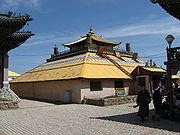
Kangyur
The Tibetan Buddhist canon is a loosely defined list of sacred texts recognized by various schools of Tibetan Buddhism, made up of the Kangyur or Kanjur and the Tengyur or Tanjur .-The Tibetan Buddhist Canon:In addition to earlier foundational Buddhist texts from early Buddhist schools, mostly...
were widely used by the Mongolian architects.
Monasteries Züün Huree (1711), Amarbayasgalant monastery
Amarbayasgalant Khiid
The Monastery of Tranquil Felicity once one of the three largest Buddhist centres in Mongolia is located near the Selenge River in the Iven Valley, at the foot of Mount Büren-Khaan in Baruunbüren sum of Selenge Province in northern Mongolia. The architectural design belongs to G. Zanabazar and...
(1727), Manjusri Hiid (1733) and others were built during this period. The mobile monastery Ihe Huree founded for Zanabazar settled at the present location of city Ulaanbaatar in 1779. The wall around Erdene Yuu monastery began to be built in 1734. It contains 108 stupas.
The Temple of Boddhisattva Avalokiteshvara was built in 1911-1913 as symbol of the new independent Bogdo Khanate of Mongolia. The colossal statue of the Boddhisattva Avalokiteshvara Migjed Janraisig, that who opens the eyes of wisdom of sentient beings, symbolised enlightenment of the Mongolian people who had opened a new page in their history and stepped into the modern civilisation.
In the beginning of the 20th century, there were around 800 monasteries throughout the country.
An interesting tendency in the beginning of the 20th century was an experiment of combining the traditional Asian architecture with the features of the Russian architectural style. Bogdo Khan had his winter palace built as a Russian "horomy". A legend holds that the Manchurian Khan was suspicious of the interest of Bogdo Gegeen VIII in the European culture. To calm down his suspicion, Bogdo Gegeen had a ganjir added to the top of the building. Another example of the combination of the Asian and Russian styles of architecture is the residence of Khanddorji Wang, a leader of the independence movement of 1911. The body of the building is designed as a Russian house while the top was designed in the 'baroque' Asian style. One of the first European buildings in Mongolia is the 2-storey building of Zanabazar Museum of Fine Arts. It was originally built as a trade centre in 1905.
Revolutionary architecture

Constructivism
Constructivist architecture
Constructivist architecture was a form of modern architecture that flourished in the Soviet Union in the 1920s and early 1930s. It combined advanced technology and engineering with an avowedly Communist social purpose. Although it was divided into several competing factions, the movement produced...
and Rationalism
Rationalism (architecture)
The intellectual principles of rationalism are based on architectural theory. Vitruvius had already established in his work De Architectura that architecture is a science that can be comprehended rationally. This formulation was taken up and further developed in the architectural treatises of the...
in architecture that flourished in the USSR also shot their roots in Mongolia, though in their most modest forms. The building of the Radio and Postal Communications Committee was the brightest example of constructivism with a pyramid-topped tower stressing its role in the town-building. This construction, unique in Mongolia, however was later disassembled. The other works constructed under the principles of constructivism and rationalism were the office of the Mongoltrans company, Ministry of Internal Affairs, and the Military Club built in the space, forms and composition order.
Classicism and "mass-production"


Classicism
Classicism, in the arts, refers generally to a high regard for classical antiquity, as setting standards for taste which the classicists seek to emulate. The art of classicism typically seeks to be formal and restrained: of the Discobolus Sir Kenneth Clark observed, "if we object to his restraint...
under the conditions of Socialism
Socialism
Socialism is an economic system characterized by social ownership of the means of production and cooperative management of the economy; or a political philosophy advocating such a system. "Social ownership" may refer to any one of, or a combination of, the following: cooperative enterprises,...
(Stalinist architecture
Stalinist architecture
Stalinist architecture , also referred to as Stalinist Gothic, or Socialist Classicism, is a term given to architecture of the Soviet Union between 1933, when Boris Iofan's draft for Palace of the Soviets was officially approved, and 1955, when Nikita Khrushchev condemned "excesses" of the past...
). The buildings of the Ministry of Foreign Affairs, the State University, the House of the Government, the Opera House, the State Library and many other public buildings that were constructed during this period demonstrate the magnificence and elegance of European Classicism.
The Mongolian architects worked to creatively combine this neo-Classicism with the traditional features of Mongolian architecture. The development of Ulaanbaatar's downtown continued at the initiative of B. Chimed who is the architect of the Drama Theater, the Natural History Museum and the Ulaanbaatar Hotel. The overall design of the Drama Theatre implemented in neo-Classicism employs the quadratic plane and double-tier marquee roof of the Mongolian architecture. These works evidence his creative search for developing the indigenous traditions in the contemporary architecture. This direction was followed by other architects, e.g. in the Urt Tsagaan (Tourists Walk) and House of Health Education (today used by the Ministry of Health) by B. Dambiinyam and the Astronomical Observatory, State University Building #2, and Meteorology Building by A. Hishigt, which cannot be mistaken for European buildings.
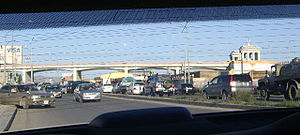

Nikita Khrushchev
Nikita Sergeyevich Khrushchev led the Soviet Union during part of the Cold War. He served as First Secretary of the Communist Party of the Soviet Union from 1953 to 1964, and as Chairman of the Council of Ministers, or Premier, from 1958 to 1964...
and Leonid Brezhnev
Leonid Brezhnev
Leonid Ilyich Brezhnev – 10 November 1982) was the General Secretary of the Central Committee of the Communist Party of the Soviet Union , presiding over the country from 1964 until his death in 1982. His eighteen-year term as General Secretary was second only to that of Joseph Stalin in...
eras in the Soviet Union
Soviet Union
The Soviet Union , officially the Union of Soviet Socialist Republics , was a constitutionally socialist state that existed in Eurasia between 1922 and 1991....
. At the same time the early 1960s were characterised by increased Soviet and Chinese
People's Republic of China
China , officially the People's Republic of China , is the most populous country in the world, with over 1.3 billion citizens. Located in East Asia, the country covers approximately 9.6 million square kilometres...
investment due to their competition for greater influence in Mongolia. Such a competition resulted in an accelerated development of the country. Thus both the older districts south of the river Dundgol and the Peace bridge were built by Chinese workers.
The architecture of the 1960s and 1970s presents the monotony of 4-, 5-, and 9-storey apartment blocks with simple rectangular shapes dictated by the need of cheap and speedy construction. The looks of cities became increasingly boring and dull. The hostility between the USSR and PRC forced Mongolia to side with only one of the two and Mongolia allied with the USSR. This external political situation led to an immensely increased influx of Soviet investment. Apartment districts were intensively built in all directions around Ulaanbaatar, including the area to the south of the Dundgol river, often by Soviet soldiers. Completely new cities were founded in Darkhan, Erdenet
Erdenet
Erdenet is the third-largest city in Mongolia and the capital of the aimag of Orkhon.Located in the northern part of the country, it lies in a valley between the Selenge and Orkhon rivers about 150 miles northwest of Ulan Bator, the capital...
and Baganuur
Baganuur
Baganuur is one of nine düüregs of the Mongolian capital of Ulaanbaatar. It is subdivided into four khoroos .Baganuur is actually a separate city, located as an exclave of 620 km² at the border between the Töv and Khentii aimags. It was created as a Soviet military base.Later Soviet Union...
during this period.
The visit of L. Brezhnev in 1974 was followed by a donation of the modern housing massif in what is now Bayangol district. This massif consists of extensive 9-storey apartment blocks decorated with five V-shaped 12-storey buildings located along the Ayush street giving it a resemblance of the famous Kalinin Avenue in the centre of Moscow
Moscow
Moscow is the capital, the most populous city, and the most populous federal subject of Russia. The city is a major political, economic, cultural, scientific, religious, financial, educational, and transportation centre of Russia and the continent...
. This street is today the busiest shopping mall in the capital of Mongolia.
Although presenting little artistic interest, the Socialist apartment districts were comfortable spacious environments for family life with safe playgrounds for children. The entire cities were designed for pedestrians. In Darkhan and Erdenet, the industries are separated from the living parts by a mountain. A pride of this epoch was the Wedding Palace in Ulaanbaatar. Designed in the Mongolian style, it was in a beautiful harmony with the Choijim Lama Monastery at its northwest. The entire area of the Wedding Palace and the Monastery were a unique architectural symphony which was unfortunately disturbed by a cacophony of business buildings that chaotically emerged in the early 21st century.
The monotony of the cities was criticised at 4 successive congresses of the Mongolian Association of Architects since 1972, however no significant improvement was achieved. The beginning of the 1980s brought new public buildings such as Museum of Lenin and the Yalalt cinema (nowadays Tengis) which added national features to the Socialist designs. The Ethnographical Museum located in the centre of Ulaanbaatar's amusement park was designed as an imaginary Mongolian castle surrounded by walls on an island in the middle of an artificial lake. The winter house of the international children's Nairamdal camp was designed as large ocean ship travelling in the sea of mountains. One of the largest monuments of the Socialist period is the National Palace of Culture. Though demonstrating some shapes of the Mongolian architecture, the basic design of the palace is found in the capitals of many former Socialist countries.
With a vision of complete replacement of yurts with apartment blocks in future, the yurt districts were seen as a temporary and transient form of housing. Therefore, during Socialism the state made no or little effort (except for bathhouses) to develop the yurt districts, which became peculiar shanty-towns of Mongolia.
Modern period
PerestroikaPerestroika
Perestroika was a political movement within the Communist Party of the Soviet Union during 1980s, widely associated with the Soviet leader Mikhail Gorbachev...
and transition to the democratic values induced two tendencies: first is the interest to the traditional culture and history and second is the interest to free liberated thinking in the arts and architecture. Virtually the entire population of Mongolia made donations to the repairs of the Chenrezig temple in the Gandan Tegchinling
Gandantegchinlen Khiid Monastery
The Gandantegchinlen Monastery , is a Tibetan-style monastery in the Mongolian capital of Ulaanbaatar that has been restored and revitalized since 1990. The Tibetan name translates to the "Great Place of Complete Joy." It currently has over 150 monks in residence...
monastery and to the re-casting of the giant statue of Boddhisattva Avalokiteshvara. A group of artists and architects led by actor Bold, an enthusiast of traditional architecture, developed an ambitious project to change Ulan Bator into a profoundly Asian city. They began constructing gates and shades in the traditional style in the Street of Revolutionaries and other streets as well as in the amusement park. The implementation of their project stopped at the beginning of the severe economic crisis. Nevertheless, the Buddhist sangha of Mongolia continued restoration of the monasteries and establishing new ones.

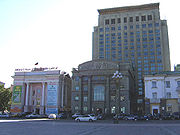
Sükhbaatar Square
Sükhbaatar Square is the central square of Ulaanbaatar, Mongolia. It is named after and features a statue of Damdin Sükhbaatar, leader of Mongolia's 1921 revolution...
is a 4-storey building implemented in the style of Classicism and it perfectly harmonises with the architectural ensemble of the 1950s. A highrise tower facing the Sükhbaatar Square would be out of space. Instead the modern style tower, the other part of the building, faces the backstreet (a similar principle is also observed with the National Palace of Culture of the previous period). Another work of this period is the Narantuul tower, recognised as one of the most elegant designs in Ulaanbaatar.
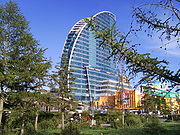
Mongol Castle
Hotel Mongolia is a hotel in the form of a mock castle near Gachuurt village, in the Bayanzürkh district of Ulan Bator , Mongolia. It claims to be the only resort hotel in the country....
in Gachuurt region of Ulaanbaatar reveals an interest of the authors in the historical past. With a Silver Tree fountain at the centre, it creates for visitors an impression of traveling in the palace of the Great Khan in ancient Karakorum
Karakorum
Karakorum was the capital of the Mongol Empire in the 13th century, and of the Northern Yuan in the 14-15th century. Its ruins lie in the northwestern corner of the Övörkhangai Province of Mongolia, near today's town of Kharkhorin, and adjacent to the Erdene Zuu monastery...
.
Prime Minister Tsakhiagiin Elbegdorj appointed a working group of professionals to develop a project to build a new city at the site of the ancient capital Karakorum. According to him, the new Karakorum was to be designed to be an exemplary city with a vision of becoming the capital of Mongolia. After his resignation and appointment of Miyeegombiin Enkhbold as Prime Minister this project was abandoned.
See also
- KhanbaliqKhanbaliqKhanbaliq or Dadu refers to a city which is now Beijing, the current capital of the People's Republic of China...
- Khara-KhotoKhara-KhotoKhara-Khoto was a Tangut city in the Ejin khoshuu of Alxa League, in western Inner Mongolia, near the former Gashun Lake. It has been identified as the city of Etzina, which appears in The Travels of Marco Polo.-History:...
- XanaduXanadu-Description of Xanadu by Toghon Temur :The lament of Toghon Temur Khan , concerning the loss of Daidu and Heibun Shanduu in 1368, is recorded in many Mongolian historical chronicles...
- Gandantegchinlen Khiid MonasteryGandantegchinlen Khiid MonasteryThe Gandantegchinlen Monastery , is a Tibetan-style monastery in the Mongolian capital of Ulaanbaatar that has been restored and revitalized since 1990. The Tibetan name translates to the "Great Place of Complete Joy." It currently has over 150 monks in residence...
- Manjusri Monastery
- Sarai (city)Sarai (city)Sarai was the name of two cities, which were successively capital cities of the Golden Horde, the Mongol kingdom which ruled Russia and much of central Asia in the 13th and 14th centuries...
- National Academic Theatre of Opera and Ballet of MongoliaNational Academic Theatre of Opera and Ballet of MongoliaThe National Academic Theatre of Opera and Ballet of Mongolia opened on 15 May 1963 and made its opening ceremony on 18 May 1963 with Tchaikovsky’s Eugene Onegin....
- Temple of the Five Pagodas
- Noin-Ula
- Orkhon ValleyOrkhon ValleyOrkhon Valley Cultural Landscape sprawls along the banks of the Orkhon River in Central Mongolia, some 360 km west from the capital Ulaanbaatar. It was inscribed by UNESCO in the World Heritage List as representing evolution of nomadic pastoral traditions spanning more than two millennia...
- Artificial Lake CastleArtificial Lake CastleThe Artificial Lake Castle was built in 1969, when the National Amusement Park was established in the centre of the Mongolian capital Ulaanbaatar....
- Mongol CastleMongol CastleHotel Mongolia is a hotel in the form of a mock castle near Gachuurt village, in the Bayanzürkh district of Ulan Bator , Mongolia. It claims to be the only resort hotel in the country....
- Ugsarmal bairUgsarmal bairUgsarmal bair , or just Ugsarmal is the Mongolian term for high rise panel buildings. Most of these buildings were built in the 1970s and 1980s with Soviet funding and Soviet designs, in order to supply a greater share of Mongolia's population with flats equipped with modern amenities...

